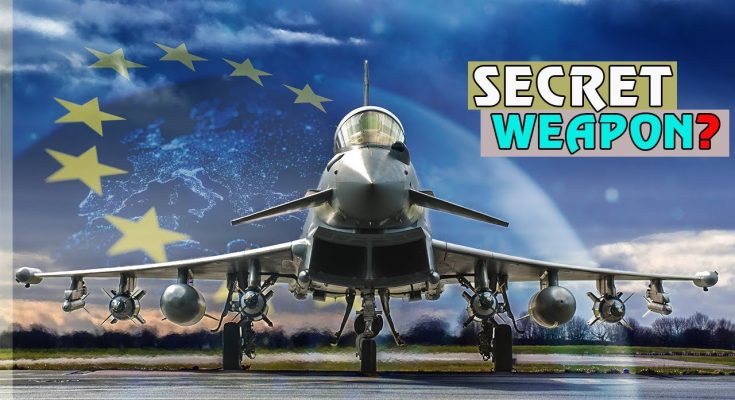Europe’s “secret weapon” in the context of air power is a topic often overlooked by many, but it’s one that has been gaining significant attention in recent years. While the United States has long been regarded as the undisputed leader in military aviation with its advanced fleet of fighter jets, bombers, and surveillance aircraft, Europe has quietly been developing its own capabilities to challenge the U.S. in the realm of air superiority. A key aspect of this is the development of advanced military technologies, collaborative defense initiatives, and strategic partnerships aimed at enhancing Europe’s air power.
The Rise of European Fighter Jets
One of the most important developments in Europe’s challenge to U.S. air power is the ongoing work on next-generation fighter jets. A standout project is the Future Combat Air System (FCAS), a collaboration between France, Germany, and Spain, aimed at developing a next-generation fighter jet by 2040. This ambitious project is designed to replace older fleets of aircraft like the French Rafale and the German Eurofighter Typhoon, both of which are already formidable but are approaching the end of their operational lifespan.
The FCAS is expected to feature cutting-edge stealth, advanced avionics, artificial intelligence (AI), and the ability to operate as part of a networked force, integrating with unmanned aerial vehicles (UAVs) and other platforms. This technological leap is intended to match or exceed the capabilities of the U.S. F-35 Lightning II and F-22 Raptor, both of which are widely regarded as the most advanced fighter jets in the world. If successful, the FCAS will not only be a powerful tool for European defense but will also signal Europe’s increasing ability to produce top-tier airpower independently of the U.S.
In addition to the FCAS, Europe has also invested heavily in the Tempest program, a British-led effort that is being developed in cooperation with Italy and Sweden. The Tempest aims to be an advanced, highly capable fighter jet that will incorporate the latest in stealth technology, AI, and advanced weaponry, further enhancing Europe’s air power in the coming decades.
The Role of NATO and European Defense Cooperation
While individual countries in Europe have been working on their own advanced fighter jets, the importance of NATO cannot be overstated when discussing Europe’s ability to challenge U.S. air power. The NATO alliance is built on mutual defense, and the combined air forces of European nations, under the NATO banner, form a formidable force.
However, recent years have seen growing discussions about European defense autonomy, with some members of the European Union pushing for a more independent military capability. The concept of “European strategic autonomy” has gained traction, especially with tensions between Europe and the U.S. over issues like defense spending and foreign policy direction. As part of this effort, Europe is developing its own rapid-response air forces, improving air defense systems, and increasing investment in advanced technologies like drones and hypersonic weapons.
Moreover, Europe’s ability to project power is not limited to fighter jets. The European Union’s growing focus on airlift and surveillance capabilities, as well as developing strategic partnerships with non-EU nations, is enhancing Europe’s broader air power. Europe’s capabilities are increasingly being integrated into joint operations, both within NATO and in other international partnerships, enhancing Europe’s standing on the global stage.
Challenging the U.S. Air Power
To challenge the U.S. air power, Europe would need to overcome significant hurdles. The U.S. Air Force remains the most advanced and largest air force in the world, with a substantial budget that dwarfs any European nation. Additionally, the U.S. military’s technological edge, particularly in the realms of AI, cyber warfare, and the integration of air, space, and cyber domains, provides a major advantage. However, the European Union’s concerted efforts to develop next-generation aircraft, combined with the growing importance of cybersecurity, data sharing, and space operations, could help level the playing field.
Another important aspect is air defense capabilities. The U.S. boasts some of the most advanced missile defense systems globally, such as the Aegis Combat System and the Patriot missile defense systems. European countries have been improving their own defense networks, such as the SAMP/T (Surface-to-Air Missile Platform/Tactical), a system designed to protect against aerial threats, including those from advanced enemy aircraft. While these systems may not yet rival those of the U.S., Europe is steadily improving its air defense capabilities.
Strategic Challenges and Cooperation
Despite these advancements, Europe faces significant strategic challenges. Political divisions within the EU and NATO can slow down the integration of air power and hinder coordination among European states. The differing defense priorities of European nations complicate efforts to create a unified air force capable of matching the U.S. Air Force’s scale and budget.
However, Europe’s path is not necessarily about matching the U.S. jet-for-jet or dollar-for-dollar. Instead, it’s about enhancing synergy—creating a network of advanced capabilities that, when combined, can challenge U.S. air power in certain theaters. This could include leveraging Europe’s technological advancements, integrating cutting-edge UAVs, hypersonic weapons, and air defense systems, and focusing on more flexible, rapid-response capabilities to complement the U.S. military’s strengths.
Conclusion
Europe’s secret weapon lies not in attempting to match the U.S. in every area of air power, but in creating a more cohesive, independent, and technologically advanced air force capable of projecting power and responding quickly to regional threats. The continued development of advanced platforms like the FCAS, Tempest, and next-generation air defense systems, along with a growing focus on European defense autonomy, signals that Europe is becoming more capable of challenging U.S. air superiority. While Europe may never completely surpass the U.S. in overall air power, its ability to play a more decisive role in modern air combat is increasingly undeniable, and that could significantly shift the dynamics of global military strategy in the years to come.



